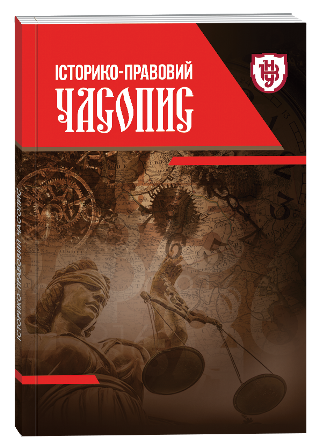THE HOLOCAUST AND ITS INVESTIGATION IN THE MEDZHYBIZH DISTRICT OF THE KAMIANETS-PODILSKYI REGION
DOI:
https://doi.org/10.32782/2409-4544/2022-1/1Keywords:
liberation, ghetto, Jews, crimes, commission, violence, occupation power, occupied territory, the regime of terror.Abstract
The article, based on the existing archival source base and the works of researchers, examines the places of ghettos and executions, establishes the periodization of the extermination of Jews, the conditions of their detention in the ghetto, the methods and scales of the Holocaust, names its organizers and participants, and also considers the process of establishing and investigating crimes of the Nazis in Medzhybizh district of Kamianets-Podilskyi region (now Khmelnytskyi district, Khmelnytskyi region). The study details the course of the Holocaust during the Nazi occupation in the Medzhybizh district of the Kamianets-Podilskyi region. The rapid offensive of the Nazis in the German-Soviet war (1941-1945) after June 22, 1941, led to the occupation of Medzhybizh on July 7. To destroy the Jewish population, a ghetto was formed immediately after the occupation. The Nazis chose the following periods to massacre the peaceful Jewish population: July 1941 (formation of the ghetto), August 21-October 31, 1942, November 1942, and January 1943 (execution of Jews). The center of Medzhybizh was chosen as the place for the temporary detention of Jews: the area of the market square and the adjacent residential quarter. Almost all Jewish residents of the town and district were driven to the ghetto. The ghetto was surrounded by barbed wire and high fences, and the local police were ordered to guard it. At first, Jews were allowed to leave the ghetto for a short time to visit the bazaar and buy food. Over time, there was a strict ban on going beyond the fence of the ghetto, the perimeter of which was controlled by a police unit. Anyone who brought food to the fence faced severe punishment - up to execution. At different times, the ghetto housed from several hundred Jews to several thousand. A feature of the Medzhybihz ghetto, in the built-up part, was the presence of extensive basements under the houses, where a certain number of Jews managed to hide. The article also defines the time, place, and methods of the Medzhybizh ghetto Holocaust. The place of executions turned out to be a tract known locally as "Popove Pole" (2 km northwest of Medzhybizh, near the road to the village of Rusanivtsi). We managed to determine the methods of extermination of the Jewish population based on the documents of the Kamianets-Podilskyi regional and Medzhybizh district commissions for the establishment and investigation of Nazi crimes, which began work in April 1944. The process of investigating the Nazi crimes of the Holocaust was followed, during which the organizers and participants of the crimes were identified. To find out the details of the crimes, the memories of both the direct participants, the policemen, and the victims who managed to escape are involved.
References
Матеріали Кам'янець-Подільської обласної комісії із встановлення і розслідування злочинів нацистів в регіоні (1944-1945 рр.) : зб. документів. Хмельницький, 2015. 454 с.
Вронська Т.В., Лисенко О.Є., Чорний Р.В. Відповідальність за державні злочини у проектах Кримінального кодексу СРСР (1946-1949). Український історичний журнал. 2012. №1. С. 121-133.
Горин М.П. Документи архіву Управління СБ України у Хмельницькій області, як джерело інформації про нацистську каторжну систему на території Кам’янець-Подільської області в 1941-1944 рр. Наукові праці Кам’янець-Подільського національного університету імені Івана Огієнка / за ред. О.М.Завальнюка. Кам’янець-Подільський, 2010. С.321-330.
Круглов О.Й., Уманьський А.І., Щупак І.Я. Холокост в Україні : монографія. Дніпро, 2016. 357 с.
Насильство над цивільним населенням України. Документи спецслужб. 1941-1944 / авт.-уклад. В.Ю. Васильєв. Київ, 2018. 752 с. 6. Снайдер Т. Криваві землі: Європа поміж Гітлером та Сталіним : монографія. Київ, 2011. 448 с.
Насильство над цивільним населенням. Вінницька область. Документи органів держбезпеки. 1941-1944 / авт.-уклад. В.Ю.Васильєв. Київ, 2020. 564 с.
Нацистський окупаційний режим в генеральній окрузі «Волинь-Поділля» (1941-1944 рр.) : зб. документів. Хмельницький, 2012. 320 с.
Нацистський окупаційний режим на Хмельниччині. 1941-1944 : зб. документів. Кам'янець-Подільський, 2009. 576 с.
Галузевий державний архів Служби безпеки України, м. Хмельницький. Ф.5. Оп. 1. Спр.25446. Арк.45-46.
100 єврейських містечок України : історичний путівник. Вип.1. Єрусалим–Санкт- Петербург, 1997. 256с.
Хоптяр Ю.А., Хоптяр А.Ю., Хоптяр А.О. Ярмолинеччина від найдавніших часів до сьогодення : монографія. Кам’янець-Подільський, 2022. 300 с.
Хоптяр А.Ю. Голокост у Кам’янець-Подільській області: хронологія, механізм, методи винищення єврейського населення (липень 1941 – січень 1943 рр.). Український історичний журнал. 2020. №3. С.90-103.
Круглов О.Й. Без жалості і сумнівів. Документи про злочини оперативних груп і команд поліції безпеки та СД на тимчасово окупованій території СРСР у 1941-1944 рр. Ч.І. Дніпропетровськ, 2008. 226 с.
Державний архів Хмельницької області. Ф-Р-946, Оп.2, Спр.7, Арк.21.
Вайнер А. Записки про меджибізьке гетто. Советиш гейм ланд. 1981. №4. С. 15-33.
Насильство над цивільним населенням. Хмельницька область. Документи органів держбезпеки. 1941-1944 / авт.-уклад. В.Ю.Васильєв. Київ, 2022. 456 с.







